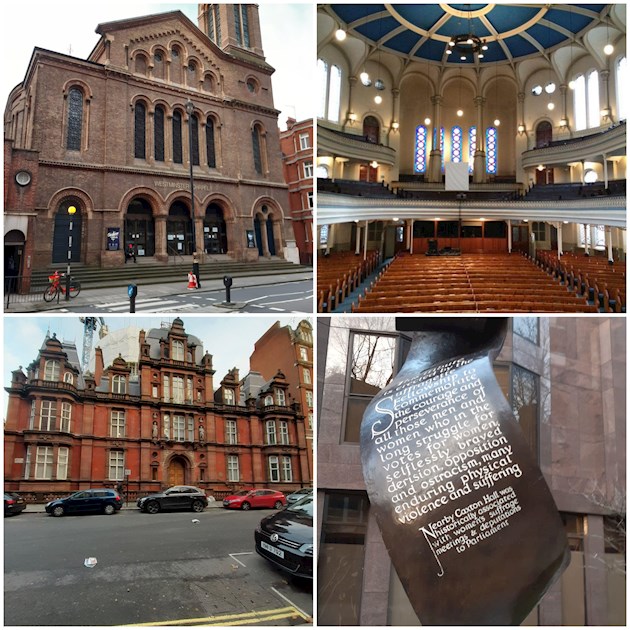1 and 2
Westminster Chapel
The congregation was formed in 1840 and its original chapel building was completed in Buckingham Gate in 1841. The congregation outgrew that building, so construction of a new chapel was begun in 1864. This building is the present chapel. It opened on 6 July 1865 and has capacity to seat about 1,500 people.
The auditorium, with seating capacity of about 1,500, is nearly oval, with two tiers of galleries and large open roof span. The galleries too are nearly oval, except that the 'circle' of the upper gallery is incomplete so as to accommodate the pipe organ. There is a high platform or daïs toward the front of the Chapel, accommodating the Communion Table and chairs for the presiding minister and the serving deacons. This platform or daïs is about three feet above the floor level. Beyond this is a large (and even higher) platform or daïs, forming a very large preaching-station or pulpit. This feature is circular and surmounted by a balustrade. It may perhaps be one of the largest pulpits in any church building
.
3 Caxton Hall
Following a design competition set by the parishes of St Margaret and St John,[the chosen design was a proposal by William Lee and F.J. Smith in an ornate Francois I style using red brick and pink sandstone, with slate roofs. The foundation stone was laid by the philanthropist, Baroness Burdett-Coutts( the name of Frank's school🙂), on 29 March 1882. The facility, which contained two public halls known as the Great and York Halls, was opened as "Westminster Town Hall" in 1883.
Caxton Hall is on the corner of Caxton Street and Palmer Street, in Westminster, London, England. It is a Grade II listed building primarily noted for its historical associations. It hosted many mainstream and fringe political and artistic events and after the Second World War was the most popular register office used by high society and celebrities who required a civil marriage
It was also used as a central London register office for weddings from October 1933 to 1978.[17] Notable people who were married there include; Donald Campbell (two marriages), Harrison Marks, Billy Butlin, Elizabeth Taylor, Diana Dors, Peter Sellers, Bernard Bresslaw, Roger Moore, Orson Welles, Joan Collins, Adam Faith, Barry Gibb and Ringo Starr. On 18 August 1952, future Prime Minister Anthony Eden married Clarissa Spencer-Churchill, the niece of the then Prime Minister Winston Churchill.
.
4 Suffargette memorial
The Suffragette Memorial is an outdoor sculpture commemorating those who fought for women's suffrage in the United Kingdom, located in the north-west corner of Christchurch Gardens, Victoria, London. The sculptors were Lorne McKean and Edwin Russell and the project was devised and supervised by the architect Paul Paget. The memorial was unveiled in 1970. It takes the form of a scroll in the shape of the letter S, created in fibreglass and finished in cold-cast bronze, placed on a conical plinth. The text of the scroll reads
This tribute is erected by the Suffragette Fellowship to commemorate the courage and perseverance of all those men and women who in the long struggle for votes for women selflessly braved derision, opposition and ostracism, many enduring physical violence and suffering.
An additional inscription notes that Caxton Hall, a nearby building on the corner of Caxton Street and Palmer Street, "was historically associated with women's suffrage meetings and deputations to Parliament". The badge of the Women's Social and Political Union and the Women's Freedom League, known as the Holloway brooch, appears on both sides of the scroll; at the back of the scroll this is accompanied by a representation of the entrance to Holloway Prison

